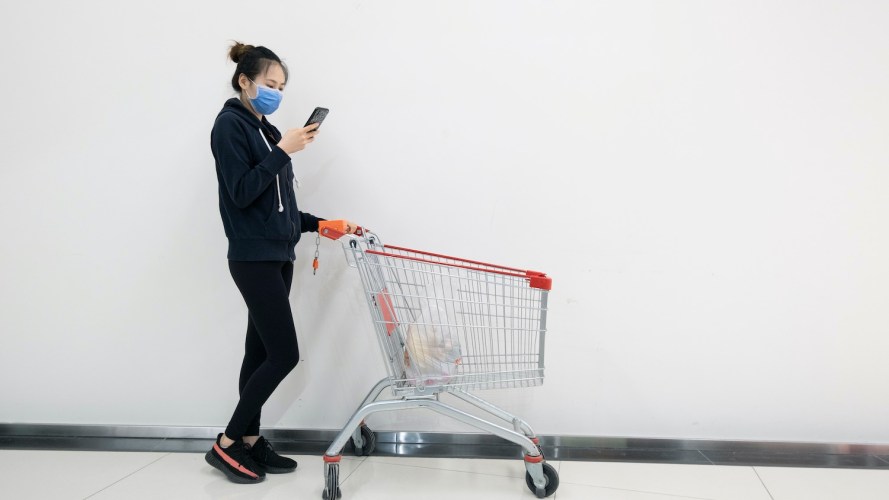Get the New Retail Playbook, your guide to building trust with today’s shoppers.
Now that all 50 states have relaxed stay-at-home measures, retailers large and small are reopening physical stores. But when they do, little in retail will seem familiar to shoppers or store associates. The pandemic forced stores to redesign, rethink, and reimagine the entire experience around new health regulations and new customer expectations.
Of course there are the “basics” of shopping in the age of COVID-19: signage asking shoppers to wear masks, plexiglass barriers, hand sanitizer and wipes, conspicuous cleaning, and primitive people-spacers like duct tape floor markers.
But, according to Big Red Rooster (BRR), a brand experience firm, retailers need to replace those temporary fixes with long-term solutions around safety and sanitation. “Retailers are just now moving beyond band-aids and are thinking about how to implement permanent changes,” says Emily Miller, VP of Strategy and Insights at BRR. This could include everything from fitting room restrictions to the amount of merchandise on the floor to checkout solutions like pay on your own device. According to research, 54% of consumers expect to see “significant” change in stores when they return to shop, anyway.
In an interview (paywall) American Eagle chief commercial officer Andrew McLean said, “From the moment you walk into our store we want you to see something that’s new. It’s many new protocols,” he said, “all are triggers in the customer’s mind that things are different now.” These fundamental alterations translate to a feeling of safety for customers, so they need to be visible and clear.
“Ship-from-store”
Even before COVID-19, I’ve watched retailers like PetSmart, Vineyard Vines, Bath & Body Works and Adidas start to use their stores as distribution points for ecommerce sales. These “ship-from-store” efforts reduce the time and cost of delivering goods to local customers from central distribution centers. Expect more of this as stores look to accommodate more and more online orders. But this is really just the beginning.
If shoppers perceive browsing as unsafe (hint: they do), they’ll visit a store on a purposeful and quick mission to acquire specific items — to get in and get out. In order to support this new behavior, retailers need to have order management and inventory systems in place to provide a real-time reflection of the stock they have in a specific store. Say an online customer wants to purchase two glass end tables from a furniture store for curbside pickup. If the store has the proper systems in place, that customer would be able to check online to make sure the tables are in stock before they bother to trek to the store to purchase them.
Some retailers may also pare down their portfolio of stores, using one or two in a particular region as a “ghost” location for inventory overflow or a pickup location for items that customers buy online. Other locations would be reserved for actual shopping and branded experiences.

Stores double as shipping nodes [Shutterstock]
Stores as … marketing channels?
That said, Doug Stephens, founder of retail industry consultancy Retail Prophet, feels stores’ core post-COVID purpose will be more about marketing and service than distribution. That means increased usage of storefronts as showrooms, event spaces, or venues for VIP and loyalty members. Store rents, he posits, will become a more economical avenue for customer acquisition than some of the legacy methods of drawing customers, such as advertising, digital marketing, paid search targeting, or offering discounts for new customers.
In line with their new function, these spaces may only display one of each item of merchandise, (despite some reports that clothing fibers are a lower risk carrier of the virus). The rest of the inventory will sit in the back of the store, perhaps sealed in protective plastic, and accessible only to associates.
“There is still a very relevant role for physical retail when it comes to learning about a brand,” says Ashley Renzi, Director of Global Direct to Consumer Strategy at New Balance. “It’s enormously important to clearly communicate the reasons for people to come to the store. What is it about the space that makes the experience special?”
The answer to that question, largely, remains to be seen.
Smart doors, smart mirrors (so much smart)
Shoppers will be able to pick up on these profound differences even before they enter stores. For starters, there will be only one dedicated door for entry and one for exit, in order to reduce congestion and the associated potential for virus transmission. And those doors? Many will become automatic to eliminate the need to touch them. If dedicated doors are not possible, store associates may serve double duty as gatekeeper, letting one person in and out at a time and keeping track of the number of people in the store.
Once inside, shoppers will find new one-way traffic patterns designed to help them avoid face-to-face interactions. Miller says some of her retail clients are even considering smart lighting to direct shoppers in a specified direction around the store. One layout option is a racetrack design in which shoppers move in one direction around merchandise displayed in the middle and around the edges of the store.
Stores will have less clutter and may even appear sparse. For example, consultancy firm Kearney advises that areas of a store “designed to increase dwell time” like couches, fixtures, and impulse buy displays, need to be removed. And get ready for smart mirrors, which take hands-free browsing to the next level, allowing you to envision yourself in a new dress or hat without ever placing it on your body. All of these measures enable social distancing, less touching of things, and moving merchandise off the floor.
Renzi adds “We’re presenting customers with relevant items in the least amount of time, moving them through the in-store journey so we can serve the next group of customers.”
Sanitation takes center stage
In the past, professional cleaning of retail stores was done in the wee hours, well out of view. Now, because research shows shoppers want assurances that the environment is clean, retailers can’t show off their cleaning practices too much. Stores will implement new CDC protocols that call for continuous wipe downs and sanitation of all areas, which may include UV lighting. Even something viewed in the past as benign, like a disorganized shelf, is a cue to shoppers that retailers aren’t bringing their sanitation A-game.
And what about common areas like fitting rooms? Some major retailers have said they won’t open them due to sanitation concerns. Where they are open, employees will clean them after each use. Miller says customers may have the option to reserve a clean fitting room ahead of time online. In a similar vein, many are considering appointment-based shopping models.
Some of the ways in which the store is changing in response to the pandemic, like contactless checkout may be permanent. Some, like hands-off browsing, may not. The crisis will impact consumer behavior in ways that perhaps we haven’t even considered yet and when it does, retailers will need to step in line with those new behaviors or risk irrelevance. All told, the crisis is asking customers and retailers to be more flexible and agile. In the words of Miller, “We can’t unlive this experience.”
Learn how to build trust with today’s shoppers with The New Retail Playbook.




























